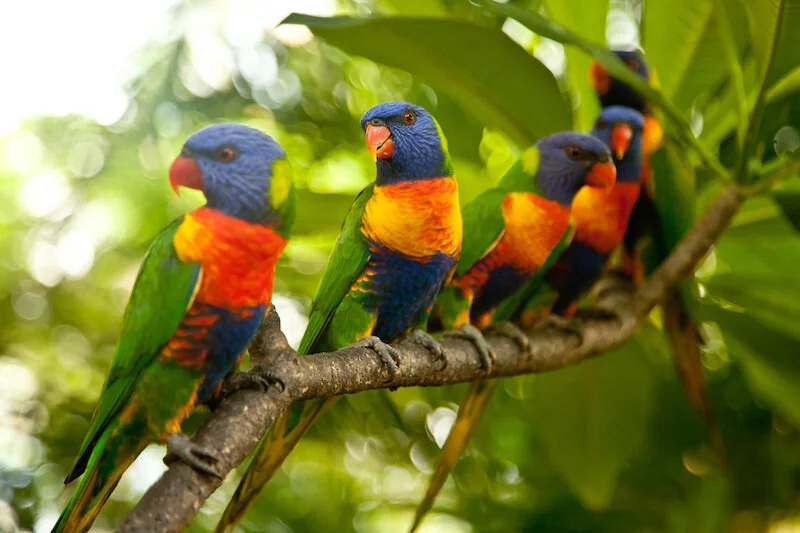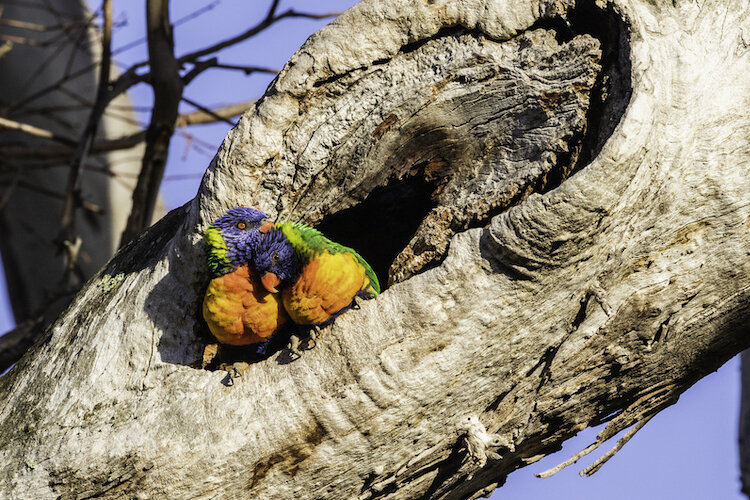Lorikeets are a kind of parrot.
They live in forests and visit gardens and parks.
Their feathers are very colourful.
They have a brush tongue to get nectar from flowers.
They fly fast and make a lot of noise.
Lorikeets are a special group of Australian parrots. There are seven species, or kinds, of lorikeet.
A row of rainbow lorikeets on a branch©Getty Images
The main difference between them and other parrots is that lorikeets feed on pollen, nectar and fruit. In order to feed on these, this group of birds has developed a brushy tip to their tongues and a smaller beak than other parrots. They also have a slightly different digestive system so they can get the most nutrition from their special diet. When animals’ bodies change over many years to adapt to their habitat, it is called adaptation.
Habitat and Distribution (where they are found)
Lorikeets are found in coastal areas around eastern and northern Australia, with one population is Western Australia. They are found in a wide range of treed habitats including rainforest and woodlands, as well as in well-treed city areas.
Appearance and Behaviours
They are medium-sized parrots, and the colours and patterns vary between the different lorikeet species. The most commonly seen are the rainbow lorikeet and the scaly-breasted lorikeet.
A scaly-breasted lorikeet. ©Getty Images
They are often seen in loud and fast-moving flocks, sometimes both species in the same flock. They cluster in groups and swoop from tree to tree calling out loudly.
One of the most colourful of Australia's parrots, the rainbow lorikeet has a dark blue head with a yellowy green collar. It has a red beak. Its belly is violet and its chest orange. Its back and tail are green and when its wings are stretched, they are orange underneath. There are yellow patches on their thighs. They are about 32 cm long, including tail. Males and females look alike.
A rainbow lorikeet in flight, showing the colourful underside of the wings. ©Getty
The scaly-breasted lorikeet has red beak and eyes, and an all green head. Upper wings and body are green, with a yellow pattern on the chest that looks like scales.
Diet and Feeding
A noisy group of rainbow lorikeets gather around a garden bird feeder. ©Getty
The tip of a lorikeet's tongue is like a stiff brush. It uses this brush tip to get nectar and pollen from inside blossoms and other flowers.
Pollen is a powdery substance produced in flowers as part of their reproduction. As a nectar-feeding bird such as a lorikeet moves from flower to flower, the pollen from one flower mixes with that of the next. This mixing is necessary for seeds to be produced.
Lorikeets sometimes eat fruits, seeds and insects. Lorikeets are also frequent visitors to seed-filled bird feeders in gardens.
Rainbow lorikeet feeding on nectar in a grevillea flower. See the sprinkling of pollen on its head, which will be deposited on the next flower it visits.©Getty Images
Life Cycle
Lorikeets lay their eggs in decayed wood, usually in a hollow limb of a eucalypt tree. Both sexes prepare the nest cavity by chewing on the decaying wood to soften it and both feed the young, but only the female incubates the eggs.
A pair of rainbow lorikeets at the opening of their tree hollow nest. ©Getty Images
The rainbow lorikeet breeds August to January, although it may breed almost year round in the tropical north.
The female lays two, occasionally three, eggs which take 23 days to hatch.The male spends a great deal of time in the hollow, but does not appear to sit on the eggs. Both parents feed the young, which leave the nest after 8 weeks.
A coconut lorikeet ©Getty
Tree hollows do not form in young eucalypts, only old ones, sometimes over a hundred years old. This means that older trees are very important for the conservation of those birds and small animals who rely on tree hollows for nesting. The logging of old growth forests has resulted in declining lorikeet numbers.
A musk lorikeet feasting in a flowering gum tree.©Getty
It’s a good idea to get information from more than one source!
Read more about lorikeets:
Watch a video about rainbow lorikeets
Read the kidcyber pages
Adaptation
A varied lorikeet ©Getty










